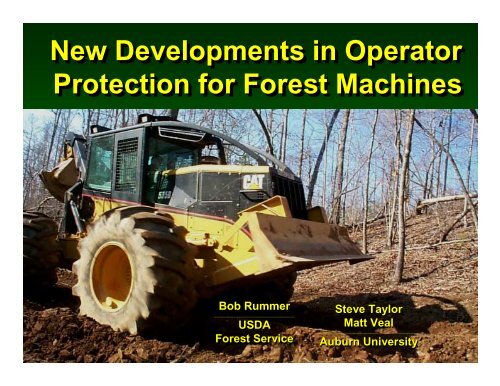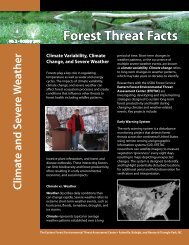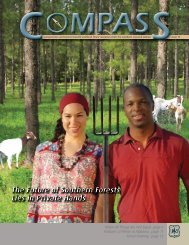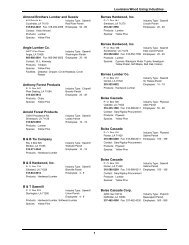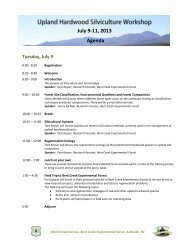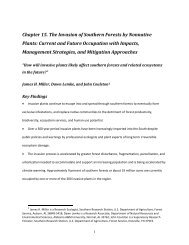New Developments in Operator Protection for Forest Machines New ...
New Developments in Operator Protection for Forest Machines New ...
New Developments in Operator Protection for Forest Machines New ...
- No tags were found...
Create successful ePaper yourself
Turn your PDF publications into a flip-book with our unique Google optimized e-Paper software.
<strong>New</strong> <strong>Developments</strong> <strong>in</strong> <strong>Operator</strong><strong>Protection</strong> <strong>for</strong> <strong>Forest</strong> Mach<strong>in</strong>esBob Rummer_________________________________USDA<strong>Forest</strong> ServiceSteve TaylorMatt Veal_________________________________________Auburn University
<strong>Forest</strong> Mechanization• <strong>Forest</strong> harvest<strong>in</strong>ghas become saferwith <strong>in</strong>creasedmechanization• Mechanizationsometimes createsnew hazards
Safety Standards• ISO 11850 provides safety requirements<strong>for</strong> <strong>for</strong>est mach<strong>in</strong>es
Safety Standards Issues:<strong>New</strong> Hazards• ISO 11850• 4.2.2.3 <strong>Operator</strong> Protective Structures“The operator shall be protected from the hazards caused by failedcha<strong>in</strong>s, teeth and similar failures us<strong>in</strong>g polycarbonate or equivalentglaz<strong>in</strong>g, or other appropriate guards or shields, or both.NOTE: Criteria are to be developed• ISO 8082 Rollover Protective Structures(ROPS):“Research is currently underway to develop a test method andcriteria <strong>for</strong> mach<strong>in</strong>es hav<strong>in</strong>g a rotat<strong>in</strong>g plat<strong>for</strong>m with cab andboom.”
In<strong>for</strong>mation Needed <strong>for</strong> <strong>New</strong>Standards Development• Groups are currently work<strong>in</strong>g on• new ROPS guidel<strong>in</strong>es <strong>for</strong> excavator-based mach<strong>in</strong>es• <strong>New</strong> Thrown Object <strong>Protection</strong> guidel<strong>in</strong>es <strong>for</strong> mach<strong>in</strong>e cabs• In<strong>for</strong>mation is needed to characterize dynamic loads andenergy exposure dur<strong>in</strong>g rollover and thrown object impacts• Goal of research at Auburn:• Characterize relationships between mach<strong>in</strong>e size and configurationand dynamic loads applied to the ROPS dur<strong>in</strong>g rollover events• Develop cab design guidel<strong>in</strong>es and procedures <strong>for</strong> test<strong>in</strong>g cabsaga<strong>in</strong>st thrown objects
ROPS Requirements• <strong>Forest</strong> mach<strong>in</strong>es that have rotat<strong>in</strong>gupper structures with cab andboom mounted on the plat<strong>for</strong>m areexcluded from the requirement <strong>for</strong>Roll Over Protective Structure
ROPS Requirements• Traditional assumptions <strong>for</strong>hydraulic excavator-basedmach<strong>in</strong>es• less susceptible to rollover– ma<strong>in</strong>ly worked on flatterra<strong>in</strong>• boom provided protection<strong>for</strong> cab dur<strong>in</strong>g rollover
Is a <strong>for</strong>estry excavator different?IncreasedcounterweightsLargerboom122-cm-tallcab riser<strong>for</strong>improvedvisibilityConventionalExcavator<strong>Forest</strong>ryConversionExcavatorTallerundercarriagewith greatergroundclearance
• Excavator-based <strong>for</strong>estmach<strong>in</strong>es now work <strong>in</strong>steep terra<strong>in</strong>ROPS Needs
ROPS Needs• Excavator-based <strong>for</strong>est mach<strong>in</strong>esnow work <strong>in</strong> steep terra<strong>in</strong>
Rigid Body Analysis• Analytical means of estimat<strong>in</strong>g levels of energy to whichthe cab will be exposed dur<strong>in</strong>g an excavator rollover.• Conservative approach• Key assumptions:– The vehicle contacts a non-de<strong>for</strong>mable surface– The vehicle impacts occur at successive contact po<strong>in</strong>ts and eachimpact is treated as a separate event– Momentum => Angular Velocity => K<strong>in</strong>etic Energy– K<strong>in</strong>etic energy equals the total work done when trajectory ofmach<strong>in</strong>e changes
• Mach<strong>in</strong>es Analyzed– Crawlers– Hydraulic Excavators– Hydraulic Excavatorsmodified <strong>for</strong> <strong>Forest</strong>ry• 46-cm cab riser• 122-cm cab riser• Dimensions gatheredfrom manufacturer specsheets and fieldmeasurementsRigid Body Analysis
20 ton Hydraulic Excavator datat = 0st = 4.425st = 4.439t = 5.194sSolution Matrixr phi phi* V V* dt t0 90 75 0 5.021677 4.42523 4.425231 137.674 2.130871 4.269176 4.341304 0.013632 4.4388622 76.80491 62.20877 2.665122 4.167868 0.755542 5.1944043 98.01368 26.11379 3.350013 4.076103 0.25955 5.4539544 105.1275 53.32787 3.916024 6.004826 0.417846 5.87185 114.4553 34.19366 4.42334 5.399857 0.207366 6.0791656 99.649 2.676965 3.969563 3.994401 0.018936 6.0981017 75.32596 67.42 3.881443 5.232882 0.602576 6.7006778 55 79.67404 0.940992 2.135675 0.84572 7.5463979 107.674 2.130871 1.815643 1.887322 0.03156 7.57795710 46.80491 3.599 1.158625 0.015452 0.217906 7.795862t = 5.454st = 5.872st = 6.079st = 6.098st = 6.701sa,b,ca) t = 7.546s b) t = 7.578s c) t = 7.796s
Analytical ResultsK<strong>in</strong>etic Energy Lost Dur<strong>in</strong>g Rollover Impact
Limitations of Rigid Body Analysis• Rigid body is a simplified 2-D 2 D analysis• Rollover events occur <strong>in</strong> 3-D 3 D space – many differentpossible contact po<strong>in</strong>ts <strong>for</strong> which 2-D 2 D analysis cannotaccount• Rigid body cannot account <strong>for</strong> energy absorption <strong>in</strong>mach<strong>in</strong>e structure and soil surface
Simulation Model<strong>in</strong>g• Multiphysics simulation models havebeen used to study per<strong>for</strong>mance ofautomobiles, aircraft, constructionequipment, etc.
Simulation Model<strong>in</strong>g of Rollover• Model<strong>in</strong>g <strong>for</strong>est mach<strong>in</strong>e per<strong>for</strong>mance is a newapplication of multiphysics simulation.• MSC.ADAMS wasused to developsimulation models ofrollover ofexcavators andcrawler tractors• Manufacturers’ literature and field measurements used todevelop three-dimensional models of the excavators• Soil surface modeled as a series of non-l<strong>in</strong>ear spr<strong>in</strong>gdampers
Simulation Results• Hydraulic excavator-based mach<strong>in</strong>e with 46-cmcm-tall cab riser
• Hydraulic excavator-based mach<strong>in</strong>e with 122-cm-tall cab riser
Effect of cab riser height on lateral<strong>for</strong>ces on the cab dur<strong>in</strong>g rolloverForce (kN)45040035030025020015010050046-cm Riser 122-cm Riser 182-cm Riser
Effect of boom position on maximum<strong>for</strong>ces on the cab dur<strong>in</strong>g rollover400350300Force (kN)250200150100500Boom A Boom B Boom C Boom D
Summary <strong>for</strong> ROPS Research• Two methods are be<strong>in</strong>g used to analyze rolloverbehavior of excavator-based <strong>for</strong>est mach<strong>in</strong>es:• Rigid Body mechanics• Multiphysics simulation• Relationships between mach<strong>in</strong>e mass and energyexposure levels dur<strong>in</strong>g rollover <strong>for</strong> typical hydraulicexcavators are similar to those of crawler tractors• <strong>Forest</strong>ry modifications can affect rollover behavior andshould be considered <strong>in</strong> safety standards• Cab risers• Boom configurationsAffect stability, energy, <strong>for</strong>ces
Thrown Object Hazards721 g37 g314 g11 g
Test<strong>in</strong>g Facility
Test Program• Steel (3 mm, 4.7 mm, 6.3 mm)• Polycarbonate (12 mm mono, 19 mm)• Velocity (60 – 150 m/s)• Sawtooth (350 g, 600 g)• Cha<strong>in</strong> l<strong>in</strong>k
High Speed Video Test Footage95 m/s, 600 g object
Polycarbonate ResultsPass Fail13 mm monoVelocity (m/s) 83 87Energy <strong>in</strong> (kJ) 6.8 7.5Energy absorbed (kJ) 6.4 6.3Velocity (m/s) 105 11319 mm 3-plyEnergy <strong>in</strong> (kJ) 11.0 13.0Energy absorbed (kJ) 10.5 12.5
Impact Result: 19 mm @ 113 m/sBirefr<strong>in</strong>gence pattern
Summary of Thrown Object Tests• At current sawhead design velocities, 6 mmsteel sk<strong>in</strong>s are necessary to withstand impact• Lam<strong>in</strong>ated 19 mm Lexan is <strong>in</strong>sufficient towithstand impact of sawhead teeth• There may be crossover between ballisticrat<strong>in</strong>g and <strong>for</strong>estry applications• Cha<strong>in</strong> shot event needs further study
Clos<strong>in</strong>g Remarks• As <strong>for</strong>est mach<strong>in</strong>es cont<strong>in</strong>ue to evolve, new issuesdevelop <strong>for</strong> safety standards• Research needs to keep pacewith new mach<strong>in</strong>edevelopments• Current results on excavatorROPS will be used <strong>in</strong> nextrevision of ISO 8082• Current results on thrown objects will be <strong>in</strong>corporated <strong>in</strong>future standards


